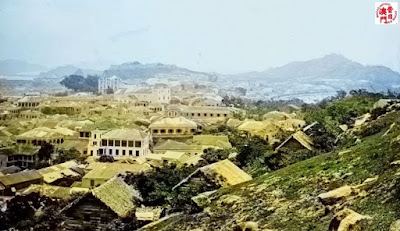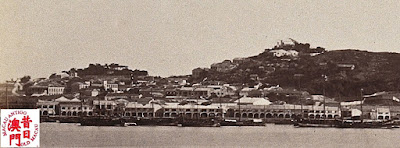Macao is a Portuguese settlement in China stands on a small peninsula projecting from the south east end of Hiang shan island. The peninsula is nearly 2 miles long less than a mile wide at its broades part and is connected with the island by a low narrow sandy isthmus across which extends a barrier wall to exclude foreigners from the interior of the island. The town is built on the declivities of the hills which surround the harbour and are 200 to 300 feet in height the shore beneath being embanked so as to form a marine parade backed by a terrace of white houses. (...)
The Inner Harbour is formed between the peninsula and Patera island to the westward. Its entrance is narrow but the depths are 20 feet at low water close to fort San Tiago or Barra which is built on the southwest point and from thence the soundings are 19 and 16 feet along the western shore to the town. Daily steam communication is maintained with Hong Kong and there is an excellent landing pier in the inner harbour. Steamers also ply between Macao and Canton making the voyage on alternate days. (...)
The port regulations now in force were issued in 1855. They require a report of the arrival of all vessels within 24 hours under a penalty of 100 dollars. Ships papers must be lodged at the office of the captain of the port. A government school of pilotage is established for the instruction and examination of pilots who are not allowed to serve unless duly qualified. The charge for bringing a vessel into the inner barbour is 7 dollars. Canton river pilots are procured at Macao and each receives a chop from the residing mandarin to deliver to the officer stationed at the Boca Tigris describing the force of the ship and to what nation she belongs.
in The China Sea Directory, Volume 3. Great Britain. Hydrographic Department, 1884. (imagens não incluídas)


Sem comentários:
Enviar um comentário